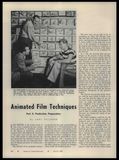
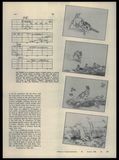
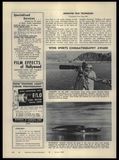

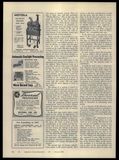

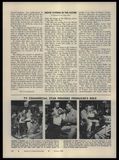
[img]THE STORY-BOARD virtually becomes the script for an animated cartoon, where the cartoon idea is visualized in drawings and brief notations. Later, it is analyzed for possible improvement. Here, group of Walt Disney cartoon creators discuss ways for “sharpening up" a cartoon idea, perhaps improving it with an additional gag or two.[/img]
LAST MONTH, in the initial article in this series, I pointed out how systematized procedure is absolutely essential in all phases of producing animated cartoons and I also defined the functions of the story man and the story sketch artist. This month we shall describe the part played by the animated cartoon director, and also the very important function of timing and music in cartoon productions.
The director of an animated cartoon, in general, has the same responsibility as the director of a live-action picture. He determines the tempo and pacing of the picture, the staging, screen performances of characters, and coordinates all of the production activities—animation, music, layouts, dialog and sound-effects recording, cutting and color — keeping all of these varied factors under the control of his experience and judgment and directing their functions toward one homogeneous result: the finished picture.
The story man can go only so far in presenting an idea; the director must take this idea and bring it to life as an active, moving piece of entertainment. If it moves badly—if the gags fail to get over, if the animation is uninspired, if the staging and cutting are confusing, if the story pacing is uneven, if the music and color are dull, no one is blamed but the director.
As a rule, the director does not participate in the process of story development before the picture reaches him for production. His contact with the story is only through an occasional story meeting prior to the time he takes over. However, story changes and improvements are liable to occur anywhere along the line during production, for there’s no telling when a new idea is going to pop up that’s better than one already in the story. But allowances can’t be made in time and money budgets for changes of this sort; the story continuity is assumed to be correct when it enters the director’s unit. So the director, all through production, is out on a limb—beset by the urge to make changes and improvements but held in check by the uncompromising limitations of the picture’s budget.
The director has become fairly familiar with the story before it lands in his lap, and has had his chance to get his two-cents’ worth in regarding its development; he really can’t blame the story man completely if he isn’t getting some funny stuff to produce. While it isn’t necessary that he be creative, he should be a good critic of gags and story values and be able to rebuild weak spots if he discovers any during the course of timing the picture.
The ideal condition would be for the story to come to the director so tight, so foolproof and so carefully worked out by the story man that from here on in it’s just a matter of animating life into it. The story man generally times his material out with a stop-watch, to make sure it will fit into the prescribed footage for a one-reel short-subject — between 600 and 700 feet. However, the story man, no matter how carefully he weighs his material, cannot analyze it as thoroughly as the director, who plans every action to the last frame of film.
[…]